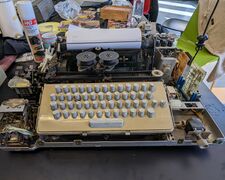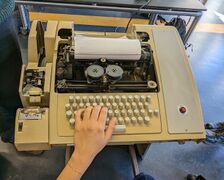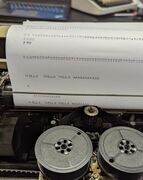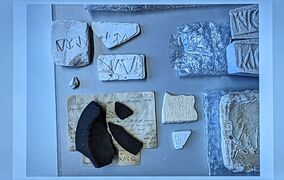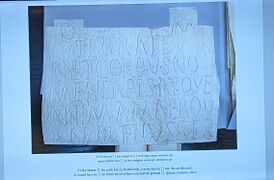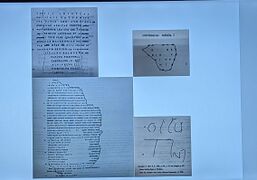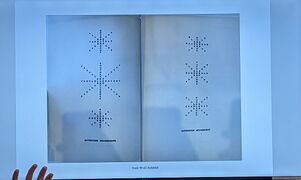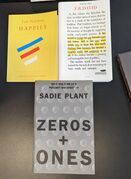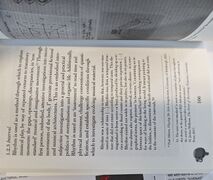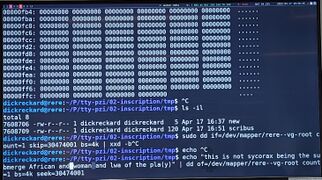User:Bnstlv/specialissue-21
01 Kick-off: TTY (Working Title)
Special Issue 21 will be in collaboration with Martino (SI21 guest editor) and 7+ artists and publishers (aka guest contributors). I'm very excited about what's planned for this trimester and looking forward to meeting all of our guests and publishing things on a weekly basis together.
In our first session, we talked with Martino about the history and different use cases of teletype machines, why TTY is interesting, and what's inside. Martino also mentioned some of his previous work, collective projects at Constant, BXL and more. We also discussed the format of the SI21, an ongoing publishing arrangement, to be released every week. It's called Blob for now. To finish off the first day of the new trimester, we read a piece by Lori Emerson Six (Difficult and Inconvenient) Values to Reclaim the Future with Old Media.
Here are a few shots of TTY:
Authors mentioned during class:
02 Week1: Andrea di Serego Alighieri and Martino
Morning | What is our relationship with writing? + Discourse on inscription
During this session, each one of us shared our personal relationship with writing, discussing the differences between writing in our native language and writing in English. Andrea then opened the discussion by explaining his approach to writing, talked about the definition of 'inscription', and looked at examples of writing (and word formatting) by various authors.
This made me think of the stella (archaeology, a big piece of stone with an inscription) we found in the Basilica in Plovdiv back in 2019 and the inscribed names on the stone.
An inscription is always meant to be read, it is not present, and it has to be deciphered. Inscriptions involve the use of tools, the body, and the hand.
Not sure if I understood it correctly, but I found it very interesting what Andrea said about how some scientists believe that due to the lack of spacing in some inscriptions, it was necessary for someone to read the text out loud, i.e. reading body and verbal reading.
We also discussed the form of ancient texts and how they are documented and studied by archaeologists and epigraphists. Andrea also referred to Emily Dickinson's pocket letters.
We then looked at examples of how to give rhythm to a text, including Norman Henry Pritchard, Lyn Hejinian (in her poetry she plays with spacing lines in alphabetical order), Karen Brodine (and her book 'Woman Sitting at the Machine Thinking'), Alice Notley, and Hannah Weiner.
Andrea also mentioned Kamau Brathwaite, with reference to the three major crises he faced in his life:
- destroyed Barbados (losing memory = lost his hard drive) - lost his wife (she had a computer, and she initially started inscribing his work) - people entered his home to rob him, put a gun to his head and pulled the trigger. However, the bullet didn't shoot, but Kamau said he basically "died" at this very moment.
One thing that I find interesting was when Andrea explained something about the challenges of using Caribbean language in Shakespeare's work (see Sycorax): "There's no way for him (Shakespeare) to use Caribbean when working on the Tempest because the language itself has to be experienced through listening, it just works differently."
I recorded a short audio of the audio recording we listened to of Kamau reading text aloud to prove the idea of authentic Caribbean inscription. (again, it is possible that I haven't understood fully what has been said in class).
Martino continued the conversation and made a few references to historical materialism, materialism in media, and materialism in Marxism, including the base-superstructure model we covered with Steve last trimester.
We also explored the notion that writing has become more fundamental than language itself, given that we are all now 'alphabetised'.
Afternoon | Writing, Revisions and Fixing breadcube
Andrea and Martino suggested doing a writing exercise. First, we had to select a page from the books A & M brought, and then edit we had to write (or rewrite) using the space between/above/below the lines. I chose to work with a quote by Helmut Kopetsky (whose work is centred around radio documentaries). Limit: compose at least 6 new sentences/lines.
I completely misunderstood the task and instead on the piece of paper I printed out, I started working directly on my wiki... I created a page, Why Radio? by Helmut Kopetsky (Berlin, Germany), and decided to do a phonetic transcription of the quote from Bulgarian to English and then I translated the piece into English. It felt right to try to 'phonetise' the text. In it, Kopetsky talks passionately about why he is doing radio, why this medium, and why matters to him. Irmak volunteered :) to be the one who reads the phonetically transcribed version and she managed to read the text really well. For sure, it sounded like non-native Bulgarian speaker, however, I was able to understand the whole piece perfectly.
This made me think how the phonetic translations of a piece of text could also serve as "encoding" the message to some extent, and only after reading it aloud, you're able to "decode" it. However, the comprehension of the message itself is only possible if the listeners can understand the language in which the text was read. One dark scenario tho, would be someone to make a phonetic transcription of a text, for example talking about global peace, and present the translated version of it which talks about global war. (Could Putin's nearly two-hour long address on Feb 21, 2022 be seen like such example?) The ability to understand something that has been said or written is a complex matter, because it is so personal. In my opinion, in mass media (tv, social media, etc.) the effects of miss- and disinformation are possible due to the rapid deployment of these "extremes", between what was inscribed and what was understood. The interesting thing here is that the narrower of the wider the gap is, it doesn't matter. It serves the same purpose, amplifying the same effect. Finding 'balance' or 'reading between the lines' seems to me to be the remedy for these bended realities. Language starts to look even more like a weapon. (referring back to Martino's line above about how fundamental writing has become as we are all now 'alphabetised')
Finally, we ended the day with Martino showing us how to do direct inscription on a hard drive (breadcube).
Some more photos of today:
03 Week1: With Roel Roscam Abbing and Martino
[ Pad: SI21, session: 3]
Morning | The legacies that are found layered in contemporary devices and networks
More oriented with STS (Science and Technology Studies; sociology, antimonopoly; disciplines from humanities that turn their glance at technology and computing). It takes the perspective of the social construction of science and technology; the relationship between the machine and humans.
- DIY Glossary
STANDARD = etymology; to standard units of measurement; normative connotation (how things should be perceived); "IMPERIAL" - all units of measurement need to be unified in a large-scale context of the world becoming a prominent place (territory). In modern times, the UK still uses "imperial unit". STANDARDISATION (ISO, International Standard Organisation) - the process of standardisation of a matter of political negotiation. One country's standard becomes 'dominant', i.e. has a competitive advantage over other countries. (examples: times (like GMT (Greenwich Mean Time) time zone is 0), currencies, degrees (Celsius or Fahrenheit), weight (kg vs pounds), distance (km vs miles), and more. INTEROPERABILITY - zooming in on the computational aspect of networks, how different standards will be able to emerge into larger standards that will go in different directions and urgencies. TTY, the urgency of using standards to make machines compatible? intra-operable. Desire to make networks compatible; the process of negotiation between market share and making it compatible with others so as to profit more from it. You never start from a clean state, infrastructures are intertwined. INSTALLED BASE (Susan Leigh-Star, 1999) LEGACY - comes from the computer world; weight that you need to work with because of history, and the previous decision has been made; you are stuck with a previous person that has worked on it. Legacy is seen as something that holds the 'break thing, move fast' notion, holding innovation back. Has a negative connotation, working with legacies", but the whole world is built on legacy stuff, countries and organisation are using computers in their workflow and decided to spend more on these systems and infrastructures because they have the money and culture, in comparison to poorer countries where investments of such scale aren't possible.
Stephen: What is the difference between the 'structure" and 'infrastructure'? 'Infra' also means underlying, together with interconnected? One structure contains another (economic structure (money) and shipping, a trade structure that carries cargo and goods).
- Reading "Open Standards" by Andrew Russell
Open Standards and the Digital Age: History, Ideology, and Networks
Afternoon:
- 1111 1111 = 255 = FF
1111 1111 = 255 = FF
Or, reading different representations of the same numbers
Binary Using 0 and 1
Known as a base 2 system, because we can express two values before we "add" another number.
a zero is written as: 0 a one is written as: 1 a two is written as: 10 a three is written as: 11 a four is written as: 100 a five is written as: 101 a six is written as: 110 a seven is written as: 111 an eight is written as: 1000
- ASCII, an 'imperial" legacy
- Inter PunyCode
- Unicode

